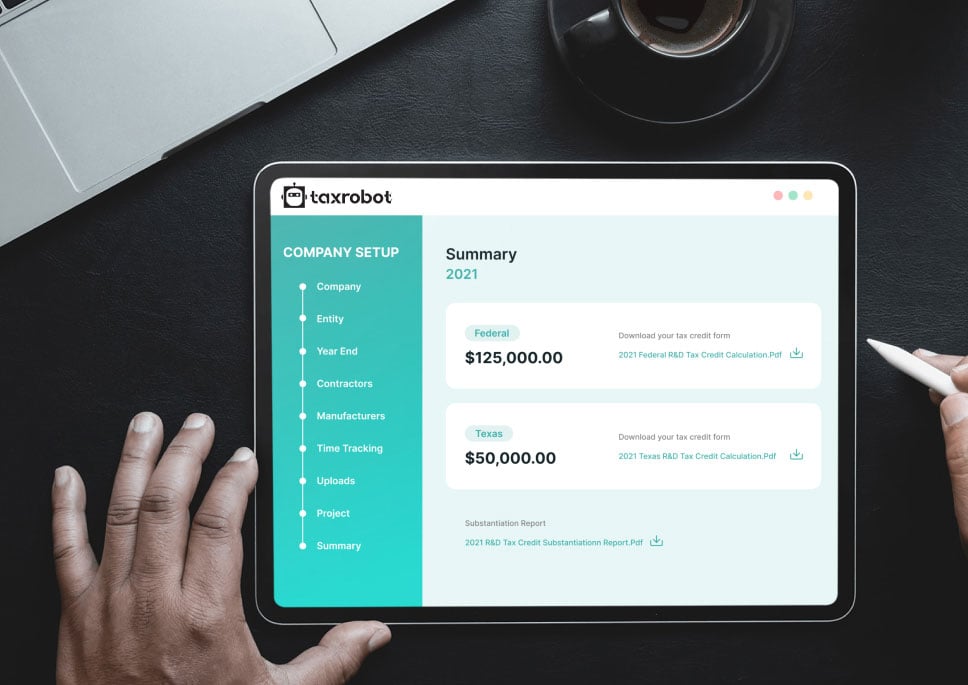Hawaii R&D Credit
Let TaxRobot help you make the most of the Hawaii R&D credit.
Maximize your State Credits today!
Put the R&D tax credit process on autopilot.
Trusted By:








Hawaii R&D Credit
Discover your eligibility for Hawaii R&D tax credits and supercharge your enterprise.
Are R&D Credits Available in Hawaii?
Yes, there are R&D tax credits that are available in Hawaii. The state wants to encourage businesses in many sectors in order to move beyond tourism. This research credit helps incentivize businesses to invest in their operations in Hawaii.
However, the credit is specific and timely. One wrong move can result in a company not getting anything from this credit. So, understanding the rules behind it completely is a big part of the process of actually obtaining the credit.
Hawaii’s Tax Credit for Research Activities
Hawaii’s R&D tax credit is a refundable credit against income tax. The credit equals 20% of all qualified research expenses a company has built up over a tax year. The credit will expire in 2024.
Hawaii is somewhat unique in that the credit is available on a first-come, first-serve basis. Each year, a certain dollar amount is allocated for this credit, with previous years allocating a $5 million cap. Once the Department of Business, Economic Development, and Tourism (DBEDT) has gone through applications that result in the exhausting of this funding, no more credits will be distributed.
This is why it is absolutely essential to submit the Hawaii tax credit application in a timely manner. These applications must be submitted by March 31st. However, the application opens on March 1st. On top of this, applicants need to fill out a questionnaire that provides additional details about the exact nature of the company’s request relating to the credit. This needs to be done by June 30th.
Federal R&D Tax Credit
The Hawaii R&D tax credit essentially uses the same system as the federal R&D tax credit. Applying for both allows companies to maximize the tax credits that are available to them. It also allows companies to take advantage of any potential research and development they conduct outside of Hawaii, as that would not qualify for the tax credit from Hawaii.
Does Your Business Qualify?
To qualify for this tax credit, the company applying for it needs to be classified as a “Qualified High Technology Business” under Hawaii state tax law. This is defined in the Hawaii tax law as a business where more than 50% of its activities are in qualified research. Qualified research is then defined as following section 41(d) of the Internal Revenue Code. This means that qualified research in Hawaii follows the federal definition of qualified research.
Do Your Research Activities Qualify?
Research activities that qualify for this credit are the same as those that qualify for the federal credit. The only real difference is that the activities must occur in Hawaii.
So, if a company conducts its research activities within the state, it can make use of this credit. If, for example, they are based in Hawaii but conduct research activities in California instead, those activities don’t count toward the credit. However, they still would qualify for the federal tax credit and may even qualify for the California R&D credit.
Make Claiming the Hawaii R&D Credit Easier with TaxRobot
With time being such an issue regarding the Hawaii R&D credit, getting it right quickly and getting it right from the very start is essential. Failing to move quickly can lead to the funding running out before your credit is approved. Making mistakes can result in other applications being picked over yours.
That is where TaxRobot can help. We have a specific software program designed entirely around getting this tax credit. This allows us to process applications quickly and accurately. With us, you have your best chance of getting this credit.
Estimate Your R&D Tax Credit Savings
Wondering just how much the Hawaii R&D credit could help save you? Use our calculator and get an estimate.
Take a sneak peak

- Limited Time Offer
- Simple Onboarding
- Easy to Use
R&D Tax Credits FAQs
The four-part test as outlined in the Internal Revenue Code is used to determine qualified R&D activity.
The Four-Part Test
1). New Or Improved Business Component
Creation of a new product, process, formula, invention, software, or technique; or improving the performance, functionality, quality, or reliability of existing business component.
- Construction of new buildings or renovation of existing buildings
- Invention of a software application
- Manufacturing of a new product or the improvement of the production process for an existing product
- Creation of design documentation
2). Technological In Nature
The activity fundamentally relies on principles of the physical or biological sciences, engineering, or computer science. A taxpayer does not need to obtain information that exceeds, expands or refines the common knowledge of skilled professionals in a particular field.
- Physics (relationship between mass, density and volume; loading as the
result of gravitational attraction) - Engineering (mechanical, electrical, civil, chemical)
- Computer science (theory of computation and design of computational systems)
3). Elimination Of Uncertainty
Uncertainty exists if the information available to the taxpayer does not establish the capability or method for developing or improving the business component, or the appropriate design of the business component.
- The capability of a manufacturer to create a part within the specified tolerances
- The appropriate method of overcoming unsuitable soil conditions during construction
- The appropriate software design to meet quality and volatility requirements
4). Process Of Experimentation
A process designed to evaluate one or more alternatives to achieve a result where the capability or method of achieving that result, or the appropriate design of that result, is uncertain as of the beginning of the taxpayer’s research activities.
- Systematic process of trial and error
- Evaluating alternative means and methods
- Computer modeling or simulation Prototyping Testing
The R&D tax credit is one of the most misunderstood tax incentives available. Considering the myriad of industries and activities that legally qualify for the credit, the term “research and development” is a misnomer. Additionally, the R&D tax credit requires specialized knowledge and technology to identify and calculate the incentive properly.
Companies of various industries are unaware that they are eligible to claim the R&D tax credit. Under the Internal Revenue Code’s definition of R&D, many common activities qualify. You can get tax benefits for industries including software, technology, architecture, engineering, construction, manufacturing, and more.
The R&D tax credit can be claimed for all open tax years. Generally, open tax years include the prior three tax years due to the statute of limitations period. In certain circumstances, the law allows businesses to claim the R&D tax credit for an extended period of time. It is common for companies to amend previous tax years to claim this benefit and reduce the maximum amount of tax liability.
Partnerships and S corporations must file this form to claim the credit. The credit will flow from the Form 6765, to the Schedule K-1, to the Form 3800 on the individual’s tax return. For individuals receiving this credit that have ownership interest in a partnership or S corporation, Form 6765 is not required on the individual return.
Individuals claiming this credit can report the credit directly on Form 3800, General Business Credit if their only source for the credit is a partnership, S corporation, estate, or trust. Otherwise, Form 6765 must be filed with the individual’s tax return (e.g. sole proprietorship).
For tax years prior to 2016, the credit can be used to reduce the taxpayer’s regular tax liability down to the tentative minimum tax. The credit cannot be used to offset alternative minimum tax. Beginning in tax year 2016, eligible small businesses have expanded utilization for the credit. For these eligible small businesses, the regular tax liability can offset alternative minimum tax using the “25/25” rule.
What our customers have to say
I highly recommend TaxRobot to anyone considering an R&D Tax Credit software to complete their analysis.

We decided to switch to TaxRobot… Best decision we’ve ever made. More affordable, and less complicated.

I couldn’t believe how easy it was! In under an hour, we saved enough money to hire a new employee.
